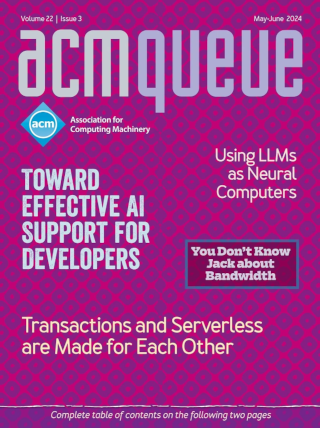WebRTC - Realtime Communication for the Open Web Platform:
What was once a way to bring audio and video to the web has expanded into more use cases we could ever imagine.
In this time of pandemic, the world has turned to Internet-based, RTC (realtime communication) as never before. The number of RTC products has, over the past decade, exploded in large part because of cheaper high-speed network access and more powerful devices, but also because of an open, royalty-free platform called WebRTC. WebRTC is growing from enabling useful experiences to being essential in allowing billions to continue their work and education, and keep vital human contact during a pandemic. The opportunities and impact that lie ahead for WebRTC are intriguing indeed.
A Second Conversation with Werner Vogels:
The Amazon CTO sits with Tom Killalea to discuss designing for evolution at scale.
When I joined Amazon in 1998, the company had a single US-based website selling only books and running a monolithic C application on five servers, a handful of Berkeley DBs for key/value data, and a relational database. That database was called "ACB" which stood for "Amazon.Com Books," a name that failed to reflect the range of our ambition. In 2006 acmqueue published a conversation between Jim Gray and Werner Vogels, Amazon's CTO, in which Werner explained that Amazon should be viewed not just as an online bookstore but as a technology company. In the intervening 14 years, Amazon's distributed systems, and the patterns used to build and operate them, have grown in influence.
Metrics That Matter:
Critical but oft-neglected service metrics that every SRE and product owner should care about
Measure your site reliability metrics, set the right targets, and go through the work to measure the metrics accurately. Then, you’ll find that your service runs better, with fewer outages, and much more user adoption.
Tracking and Controlling Microservice Dependencies:
Dependency management is a crucial part of system and software design.
Dependency cycles will be familiar to you if you have ever locked your keys inside your house or car. You can’t open the lock without the key, but you can’t get the key without opening the lock. Some cycles are obvious, but more complex dependency cycles can be challenging to find before they lead to outages. Strategies for tracking and controlling dependencies are necessary for maintaining reliable systems.
Designing Cluster Schedulers for Internet-Scale Services:
Embracing failures for improving availability
Engineers looking to build scheduling systems should consider all failure modes of the underlying infrastructure they use and consider how operators of scheduling systems can configure remediation strategies, while aiding in keeping tenant systems as stable as possible during periods of troubleshooting by the owners of the tenant systems.
Canary Analysis Service:
Automated canarying quickens development, improves production safety, and helps prevent outages.
It is unreasonable to expect engineers working on product development or reliability to have statistical knowledge; removing this hurdle led to widespread CAS adoption. CAS has proven useful even for basic cases that don’t need configuration, and has significantly improved Google’s rollout reliability. Impact analysis shows that CAS has likely prevented hundreds of postmortem-worthy outages, and the rate of postmortems among groups that do not use CAS is noticeably higher.
Hootsuite: In Pursuit of Reactive Systems:
A discussion with Edward Steel, Yanik Berube, Jonas Bonér, Ken Britton, and Terry Coatta
It has become apparent how critical frameworks and standards are for development teams when using microservices. People often mistake the flexibility microservices provide with a requirement to use different technologies for each service. Like all development teams, we still need to keep the number of technologies we use to a minimum so we can easily train new people, maintain our code, support moves between teams, and the like.
The Calculus of Service Availability:
You’re only as available as the sum of your dependencies.
Most services offered by Google aim to offer 99.99 percent (sometimes referred to as the "four 9s") availability to users. Some services contractually commit to a lower figure externally but set a 99.99 percent target internally. This more stringent target accounts for situations in which users become unhappy with service performance well before a contract violation occurs, as the number one aim of an SRE team is to keep users happy. For many services, a 99.99 percent internal target represents the sweet spot that balances cost, complexity, and availability.
The Hidden Dividends of Microservices:
Microservices aren’t for every company, and the journey isn’t easy.
Microservices are an approach to building distributed systems in which services are exposed only through hardened APIs; the services themselves have a high degree of internal cohesion around a specific and well-bounded context or area of responsibility, and the coupling between them is loose. Such services are typically simple, yet they can be composed into very rich and elaborate applications. The effort required to adopt a microservices-based approach is considerable, particularly in cases that involve migration from more monolithic architectures. The explicit benefits of microservices are well known and numerous, however, and can include increased agility, resilience, scalability, and developer productivity.
Fail at Scale:
Reliability in the face of rapid change
Failure is part of engineering any large-scale system. One of Facebook’s cultural values is embracing failure. This can be seen in the posters hung around the walls of our Menlo Park headquarters: "What Would You Do If You Weren’t Afraid?" and "Fortune Favors the Bold."
HTTP/2.0 - The IETF is Phoning It In:
Bad protocol, bad politics
In the long run, the most memorable event of 1989 will probably be that Tim Berners-Lee hacked up the HTTP protocol and named the result the "World Wide Web." Tim’s HTTP protocol ran on 10Mbit/s, Ethernet, and coax cables, and his computer was a NeXT Cube with a 25-MHz clock frequency. Twenty-six years later, my laptop CPU is a hundred times faster and has a thousand times as much RAM as Tim’s machine had, but the HTTP protocol is still the same.
Node at LinkedIn: The Pursuit of Thinner, Lighter, Faster:
A discussion with Kiran Prasad, Kelly Norton, and Terry Coatta
Node.js, the server-side JavaScript-based software platform used to build scalable network applications, has been all the rage among many developers for the past couple of years, although its popularity has also managed to enrage some others, who have unleashed a barrage of negative blog posts to point out its perceived shortcomings. Still, while new and untested, Node continues to win more converts.
Center Wheel for Success:
Not invented here syndrome is not unique to the IT world.
When I first read the claim that HealthCare.gov, the Web site initiated by the Affordable Care Act, had cost $500 million to create, I didn’t believe the number. There is no way to make a Web site cost that much. But the actual number seems not to be an order-of-magnitude lower, and as I understand the reports, the Web site doesn’t have much to show for the high cost in term of performance, features, or quality in general.
Sender-side Buffers and the Case for Multimedia Adaptation:
A proposal to improve the performance and availability of streaming video and other time-sensitive media
The Internet/Web architecture has developed to the point where it is common for the most popular sites to operate at a virtually unlimited scale, and many sites now cater to hundreds of millions of unique users. Performance and availability are generally essential to attract and sustain such user bases. As such, the network and server infrastructure plays a critical role in the fierce competition for users. Web pages should load in tens to a few hundred milliseconds at most.
How Do I Model State? Let Me Count the Ways:
A study of the technology and sociology of Web services specifications
There is nothing like a disagreement concerning an arcane technical matter to bring out the best (and worst) in software architects and developers. As every reader knows from experience, it can be hard to get to the bottom of what exactly is being debated. One reason for this lack of clarity is often that different people care about different aspects of the problem. In the absence of agreement concerning the problem, it can be difficult to reach an agreement about the solutions.
Commentary: A Trip Without a Roadmap:
Instead of simply imagining what your users want or need, it’s always a good idea to first get their input.
Viewed broadly, programming projects fail far more often than they succeed. In some cases, failure is a useful step toward success, but all too often it is simply failure.
High Performance Web Sites:
Want to make your Web site fly? Focus on front-end performance.
Google Maps, Yahoo! Mail, Facebook, MySpace, YouTube, and Amazon are examples of Web sites built to scale. They access petabytes of data sending terabits per second to millions of users worldwide. The magnitude is awe-inspiring. Users view these large-scale Web sites from a narrower perspective. The typical user has megabytes of data that are downloaded at a few hundred kilobits per second. Users are not so interested in the massive number of requests per second being served; they care more about their individual requests.
Improving Performance on the Internet:
Given the Internet’s bottlenecks, how can we build fast, scalable content-delivery systems?
When it comes to achieving performance, reliability, and scalability for commercial-grade Web applications, where is the biggest bottleneck? In many cases today, we see that the limiting bottleneck is the middle mile, or the time data spends traveling back and forth across the Internet, between origin server and end user.
Eventually Consistent:
Building reliable distributed systems at a worldwide scale demands trade-offs?between consistency and availability.
At the foundation of Amazon’s cloud computing are infrastructure services such as Amazon’s S3 (Simple Storage Service), SimpleDB, and EC2 (Elastic Compute Cloud) that provide the resources for constructing Internet-scale computing platforms and a great variety of applications. The requirements placed on these infrastructure services are very strict; they need to score high marks in the areas of security, scalability, availability, performance, and cost effectiveness, and they need to meet these requirements while serving millions of customers around the globe, continuously.
Building Scalable Web Services:
Build only what you really need.
In the early days of the Web we severely lacked tools and frameworks, and in retrospect it seems noteworthy that those early Web services scaled at all. Nowadays, while the tools have progressed, so too have expectations with respect to richness of interaction, performance, and scalability. In view of these raised expectations it is advisable to build only what you really need, relying on other people’s work where possible. Above all, be cautious in choosing when, what, and how to optimize.
Toward a Commodity Enterprise Middleware:
Can AMQP enable a new era in messaging middleware? A look inside standards-based messaging with AMQP
AMQP was born out of my own experience and frustrations in developing front- and back-office processing systems at investment banks. It seemed to me that we were living in integration Groundhog Day - the same problems of connecting systems together would crop up with depressing regularity. Each time the same discussions about which products to use would happen, and each time the architecture of some system would be curtailed to allow for the fact that the chosen middleware was reassuringly expensive. From 1996 through to 2003 I was waiting for the solution to this obvious requirement to materialize as a standard, and thereby become a commodity.
A Conversation with Werner Vogels:
Learning from the Amazon technology platform: Many think of Amazon as ’that hugely successful online bookstore.’ You would expect Amazon CTO Werner Vogels to embrace this distinction, but in fact it causes him some concern.
Many think of Amazon as "that hugely successful online bookstore." You would expect Amazon CTO Werner Vogels to embrace this distinction, but in fact it causes him some concern. "I think it’s important to realize that first and foremost Amazon is a technology company," says Vogels. And he’s right. Over the past years, Vogels has helped Amazon grow from an online retailer (albeit one of the largest, with more than 55 million active customer accounts) into a platform on which more than 1 million active retail partners worldwide do business.
Monitoring, at Your Service:
Automated monitoring can increase the reliability and scalability of today’s online software services.
Internet services are becoming more and more a part of our daily lives. We derive value from them, depend on them, and are now beginning to assume their ubiquity as we do the phone system and electricity grid. The implementation of Internet services, though, is an unsolved problem, and Internet services remain far from fulfilling their potential in our world.
A Conversation with Phil Smoot:
The challenges of managing a megaservice
In the landscape of today’s megaservices, Hotmail just might be Mount Everest. One of the oldest free Web e-mail services, Hotmail relies on more than 10,000 servers spread around the globe to process billions of e-mail transactions per day. What’s interesting is that despite this enormous amount of traffic, Hotmail relies on less than 100 system administrators to manage it all.
A Conversation with Tim Bray:
Searching for ways to tame the world’s vast stores of information.
Tim Bray’s Waterloo was no crushing defeat, but rather the beginning of his success as one of the conquerors of search engine technology and XML. In 1986, after working in software at DEC and GTE, he took a job at the University of Waterloo in Ontario, Canada, where he managed the New Oxford English Dictionary Project, an ambitious research endeavor to bring the venerable Oxford English Dictionary into the computer age.
A Conversation with Brewster Kahle:
Creating a library of Alexandria for the digital age
Stu Feldman, Queue board member and vice president of Internet technology for IBM, interviews the chief executive officer of the nonprofit Internet Archive.
A Conversation with Wayne Rosing:
How the Web changes the way developers build and release software
Google is one of the biggest success stories of the recent Internet age, evolving in five years from just another search engine with a funny name into a household name that is synonymous with searching the Internet. It processes about 200 million search requests daily, serving as both a resource and a challenge to developers today.
Caching XML Web Services for Mobility:
In the face of unreliable connections and low bandwidth, caching may offer reliable wireless access to Web services.
Web services are emerging as the dominant application on the Internet. The Web is no longer just a repository of information but has evolved into an active medium for providers and consumers of services: Individuals provide peer-to-peer services to access personal contact information or photo albums for other individuals; individuals provide services to businesses for accessing personal preferences or tax information; Web-based businesses provide consumer services such as travel arrangement (Orbitz), shopping (eBay), and e-mail (Hotmail); and several business-to-business (B2B) services such as supply chain management form important applications of the Internet.
Scripting Web Services Prototypes:
As web services become increasingly sophisticated, their practitioners will require skills spanning transaction processing, database management, middleware integration, and asynchronous messaging.
IBM Lightweight Services (LWS), an experimental hosting environment, aims to support rapid prototyping of complex services while insulating developers from advanced issues in multi-threading, transactions, and resource locking. To achieve this we adapt a high-level, event-driven, single-threaded scripting environment to server-side application hosting. Developers may use this freely available environment to create robust web services that store persistent data, consume other services, and integrate with existing middleware. Lightweight services are invoked by standard HTTP SOAP clients, and may in turn invoke other web services using WSDL.
Interview with Adam Bosworth:
The changes that are going to be driven by web services will result in a major language extension.
Adam Bosworth’s contributions to the development and evolution of Web Services began before the phrase "Web Services" had even been coined. That’s because while working as a senior manager at Microsoft in the late ’90s, he became one of the people most central to the effort to define an industry XML specification. While at Microsoft, he also served as General Manager of the company’s WebData organization (with responsibility for defining Microsoft’s long-term XML strategy) in addition to heading up the effort to develop the HTML engine used in Internet Explorer 4 & 5.
Securing the Edge:
Common wisdom has it that enterprises need firewalls to secure their networks.
Common wisdom has it that enterprises need firewalls to secure their networks. In fact, as enterprise network practitioners can attest, the "must-buy-firewall" mentality has pervaded the field.
Web Services: Promises and Compromises:
Much of web services’ initial promise will be realized via integration within the enterprise.
Much of web services’ initial promise will be realized via integration within the enterprise, either with legacy applications or new business processes that span organizational silos. Enterprises need organizational structures that support this new paradigm.
An Open Web Services Architecture:
The name of the game is web services.
The name of the game is web services-sophisticated network software designed to bring us what we need, when we need it, through any device we choose. We are getting closer to this ideal, as in recent years the client/server model has evolved into web-based computing, which is now evolving into the web services model. In this article, I will discuss Sun Microsystems’ take on web services, specifically Sun ONE: an open, standards-based web services framework. I’ll share with you Sun’s decision-making rationales regarding web services, and discuss directions we are moving in.
The Deliberate Revolution:
Transforming Integration With XML Web Services
While detractors snub XML web services as CORBA with a weight problem, industry cheerleaders say these services are ushering in a new age of seamless integrated computing. But for those of us whose jobs don’t involve building industry excitement, what do web services offer?






